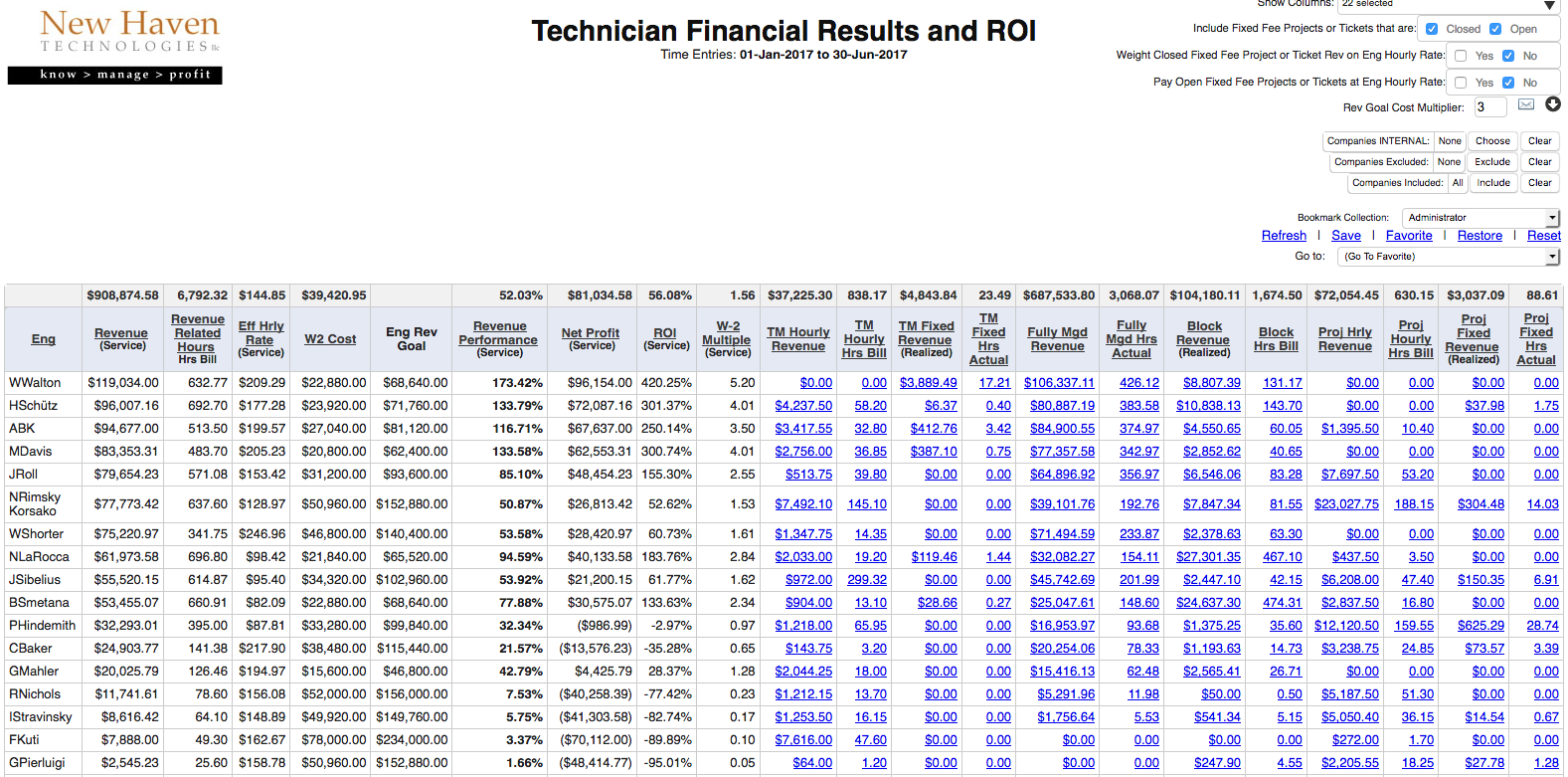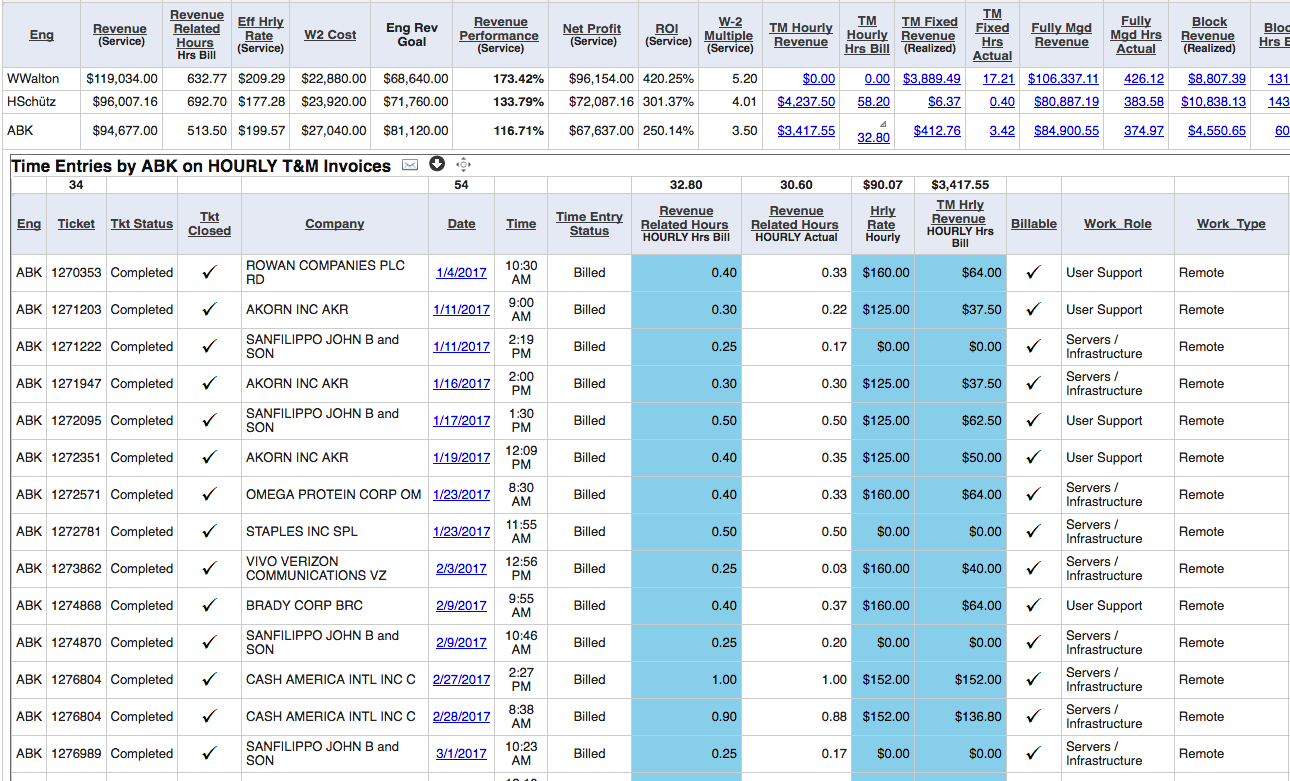Technician Financial Results and ROI
Which engineer is responsible for the most profit?

Shows how much revenue each engineer is responsible for driving across all types of assignments (T&M, Fully Managed, Projects, including fixed fee or hourly engagements.)
(click image to enlarge)
FROM THIS I KNOW:
- WWalton is my top revenue-producing engineer with a W-2 multiple of 5.20 and a net profit exceeding $96k and an ROI return of 420%.
- Effective Hourly Rate across all the engineers is $144 per hour
- There are 6 engineers listed on the report where their W-2 cost exceeded the revenue that they were responsible for driving over the period
PURPOSE
The purpose of the “Technician Financial Results and ROI” report is to provide a “scorecard” for the revenue generated by each engineer, and compare that revenue to their W-2 cost. For most client-focused engineers, industry averages suggest that they should be driving revenue equal or greater than “3x” what they cost your organization (i.e. W-2 cost). This is known as “W-2 multiple” for each engineer.
WHY IS THIS IMPORTANT?
There are many reasons why you want to know this, but the most important one is “profitability” of your organization. You need to make sure that each engineer “covers” their cost to your organization by the work that they do for clients (and as said above, industry best practices suggest they should be driving 3x their cost).
REVENUE CALCULATIONS PER TYPE OF ENGAGEMENT
“Hourly” Service Tickets – Revenue is calculated for each engineer by multiplying the time spent on each time entry for each client “times” the hourly billing rate that the client is ultimately invoiced for that work. (i.e. # hours * hourly rate).
Hourly rate: Rate that the client is billed per hour as designated on the service ticket.
Fully Managed (fixed fee) – On Fully Managed agreements, the client pays a “flat fee” at the beginning of the month, and hours are spent throughout the month against that agreement. The “hourly rate” used to award revenue to each engineer is based on the total fee that the client was charged (i.e. the “revenue”) divided by the TOTAL number of hours worked by ALL engineers on that Fully Managed agreement that month. So if the client paid $1,000 and the engineering team spent a total of 10 hours on that agreement that month, then each engineer would be awarded $100 per each hour that they spent on that agreement.
“Fixed Fee” Projects and Service Tickets – Both projects and individual service tickets can be designated as “fixed fee” such that the client pays a set price no matter how much labor is devoted to that project or ticket. In this case, the “hourly rate” used to award revenue to each engineer works in a similar fashion to the Fully Managed agreements. The hourly rate is calculated by taking the total fee paid by the client and dividing that by the TOTAL hours spent by ALL engineers on that project or ticket.
HOW DO I KNOW THAT THE CALCULATIONS ARE CORRECT?
Let’s face it, the calculations can get pretty complicated very quickly, especially on “fixed fee” scenarios where we first have to calculate the “hourly rate” (based on work that EVERYONE has done) before we can award any revenue to a specific engineer. So we provide a “drill-down” on each entry so that you can see exactly HOW that number was calculated. Just click on the revenue or hours for that engineer for that particular type of scenario. Here’s what it looks like:
“Hourly” Service Tickets
Fully Managed


